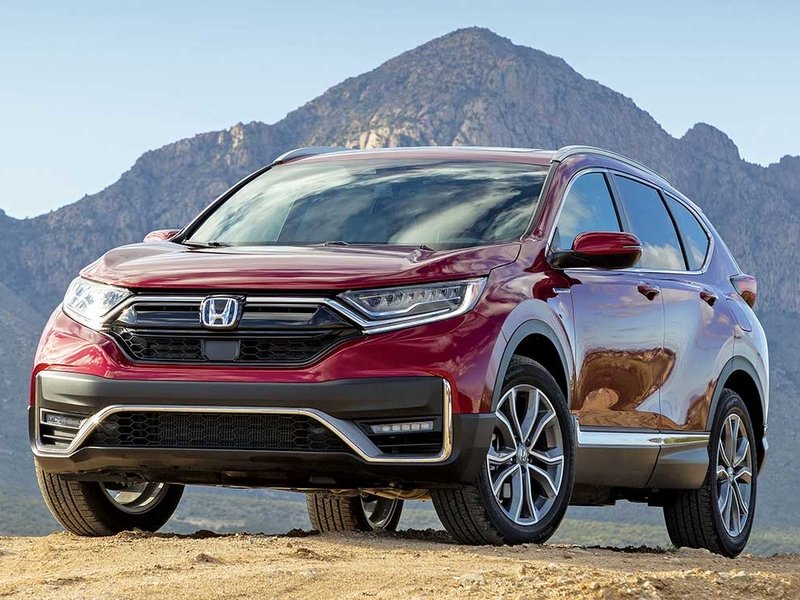
Honda’s timing to bring the hybrid version of its popular CR-V compact crossover to America was looking pretty good right up until a few weeks ago.
After receiving mostly positive reviews following its introduction in Europe last year, the Japanese brand’s first electrified crossover was ready to do battle with the redesigned Ford Escape Hybrid that hit the market in December and the strong-selling Toyota RAV4 Hybrid, now in its second generation.
The expectation for crossover hybrid sales was evident in the decision by the three automakers to build their electrified versions in the U.S. No longer niche products shipped from afar, hybrids looked to become a healthy subsegment of the already-crowded compact crossover group.
But alas, the CR-V Hybrid’s arrival in showrooms in early March coincided with an oil-price war, a global pandemic and a world turned upside down. Gasoline is cheap, consumers are pulling back from the auto market in general, and environmental concerns are not currently top of mind.
It won’t be forever, though, according to analysts.
When auto sales return to healthy levels, hybrid crossovers are poised to become mainstream vehicles because of the maturation of the technology. They were once rolling science experiments with little power and weird styling, but now hybrids represent a step up from their gasoline-only counterparts.
And when the market does come back, there are likely to be new competitors in the segment. Hyundai sells a hybrid Tucson in Europe. The next-generation version of the compact crossover is likely to include a hybrid variant for the U.S. Kia’s next Sportage should follow suit at some point. And the discontinued Nissan Rogue Hybrid is expected to make a reprise when the Rogue lineup enters its next generation.
In the case of the CR-V, RAV4 and Escape, the hybrid versions all offer more power than the standard gasoline engines. They are subjectively more fun to drive because of the jolt of electrons from standstill, and they are more refined thanks to the silent electric motor at low speeds.
“One of the things about the new generation of hybrids is they’re not as sluggish as they used to be,” said Sam Abuelsamid, principal research analyst at Navigant Research. “They all drive pretty well now and have decent acceleration.”They also get around 40 mpg in combined highway/city driving.
Last year, U.S. RAV4 Hybrid volume nearly doubled to 92,525 — accounting for 1 in 5 sales of the fourth-best-selling nameplate in the country. Part of the reason for that high take rate is the generally modest price premium — a $1,000 difference between comparable all-wheel-drive trims — along with a performance upgrade.
“The thing about the U.S. market is gas remains cheap, and it looks like it’s going to get even cheaper,” said Abuelsamid. “American consumers today don’t really seem to be inclined to pay a premium for 45 mpg, but they’ll pay for something that gets to 60 mph a half a second quicker.”
Automakers have finally switched their strategy of trying to squeeze out as many hybrid miles per gallon as possible while sacrificing everything else, including styling. The new hybrids look pretty much like their gasoline-only counterparts. Mainstream consumers want normalcy over green credentials.
The CR-V Hybrid is almost indistinguishable from the gasoline version. There is a blue hue in the front Honda badge, a hybrid stamp at the rear and a unique bumper that hides the tailpipes. The RAV4 Hybrid has a unique trim, the XSE, with black wheels and two-tone paint job. Likewise, Ford sells the Escape as a “Sport Hybrid” with black wheels and chrome. But they’re still designed to be mainstream vehicles.
One reason for the change in attitude by manufacturers is that hybrids are increasingly important toward meeting corporate average fuel economy targets. Plug-in hybrid options are becoming increasingly popular on the higher trims of premium vehicles because of the performance boost.
Ford is planning a hybrid F-150 pickup that has the advantage of being able to run power tools without an external generator. Fiat Chrysler Automobiles is planning plug-in hybrid Jeeps. Ford and Toyota have already announced plug-in hybrid versions of the RAV4 and Escape coming this year. Toyota is billing the 302-hp RAV4 Prime plug-in hybrid as “the most powerful and quickest” version yet.
The arrival of the hybrid era — as marked by the three compact crossover models now on sale — is also logical. The vehicles drive better, the price premium is minimal, and the benefits of electrified powertrains, at least in Toyota models, include improved reliability.
“I think the numbers you see around the RAV4 Hybrid are proof that we are moving out of kind of niche, green-oriented consumers to mainstream consumers, and it makes perfect sense in my mind,” said Karl Brauer, executive publisher of Kelley Blue Book and Autotrader. “The early hybrids weren’t easy to justify. They performed worse, they cost more, and the fuel-efficiency benefits were mediocre at best.”
That equation, he said, has now been flipped.
“They’re finally getting to where the cost difference isn’t much, and the engineering is actually making them better — not just at fuel efficiency, but at performance, too. They’re basically just better cars. They’re more refined, they’re quieter, they get better mileage, and they’re quicker, too,” Brauer said.
The coronavirus may have put the hybrid era on hold for a little while longer in the U.S. But with electrified vehicles as good as these, along with government efficiency regulations and societal pressure to reduce emissions, the march forward is likely to resume when a state of normalcy returns.